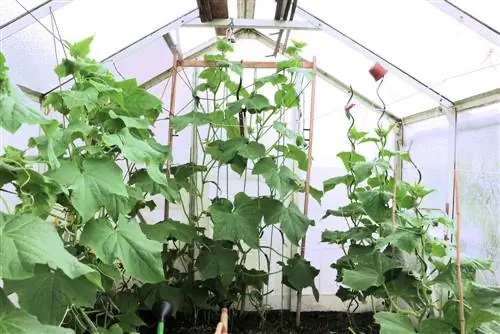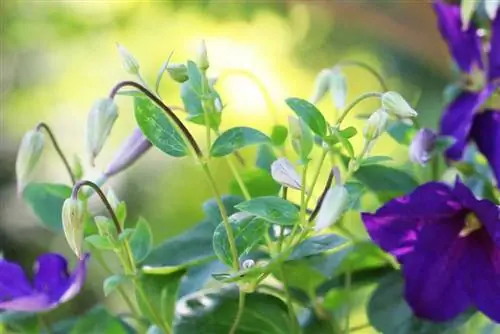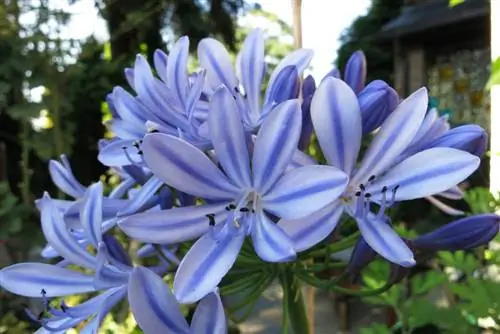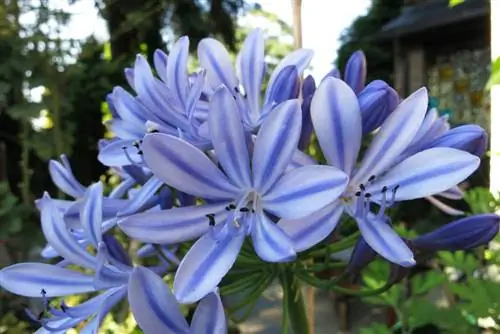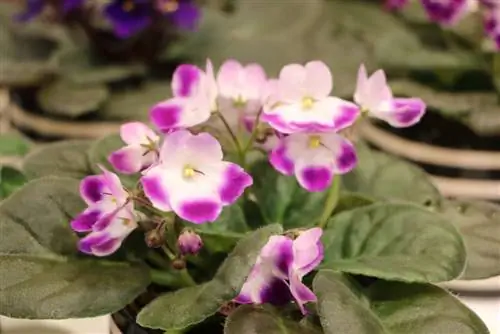- Author admin [email protected].
- Public 2023-12-17 03:39.
- Last modified 2025-01-24 12:45.
The African climbing lily Gloriosa rothschildiana brings an unusual beauty into the garden. Her origin is Africa. This lily gracefully and attractively climbs a good 2 meters up a trellis. The beautiful exotic lily flowers emerge from the leaf axils on the long stems and create wonderful accents.
If you are looking for something special for your terrace or garden, you will be able to fulfill your dream with the African climbing lily. It is the only climbing lily and is therefore something very special for every lover of the unusual. Their expressiveness lies in the colorfulness of their flowers and their perfect beauty.
General
- Their common names are: magnificent lily, flame lily or tiger claw
- It belongs to the plant family Colchicaceae, the timeless plants
- The name of this species is 'crown of glory'
- The scientific name is Gloriosa rothschildiana
- Home is the tropics and the subtropics
- A climbing plant whose tendrils grow up to 2 meters long
- Rhizolike rootstock
- Not hardy
- The flowering period begins in February in the greenhouse and in June outdoors
- The flowers are often purple-red with yellow, wavy edges
- It is one of the highly poisonous ornamental plants
Tip:
The water balance plays a central role in all tropical plants. Care therefore requires a little attention.
Location
All known species of African climbing lily require a lot of light and sun. A bright, sunny and wind-protected outdoor space is just right in summer.
- wind-protected, bright location
- No blazing sun, due to risk of sunburn
- Temperatures between 18° C and 22° C are ideal
- In summer the minimum temperature is 17° C
Flowering period from June to September

When the Ice Saints are over, the Gloriosa rothschildiana can be brought to the garden location. Large fluctuations in temperature and air should be avoided, otherwise flowers and leaves will turn brown.
Substrate
The magnificent lily grows in nutritious and humus-rich soil in its homeland. This is also how the substrate should be in the planter in which the plant is cultivated.
- A mixture of potting soil, sand and peat in equal parts is optimal.
- As an alternative, a mixture of equal parts leaf mold, compost and perlite is also possible.
- The mixture should be well permeable, humic and nutritious
- Waterlogging inevitably means the end of this magnificent plant.
Planter
Since the African climbing lily has a great urge to climb, it is ideally cultivated in a planter that has a trellis. Mobile flower boxes with a trellis have proven useful here. Not only can they be used flexibly, but they also serve as decorative privacy screens. Things to note when planting:
- The planter must definitely have a drainage hole for irrigation water
- A drainage made of potsherds or small stones is placed on top of this
- Fill in substrate and do not plant the plant deeper than it was in the previous pot
- Be sure to leave a pouring edge of a good 5 cm free
- Water the crown of glory well after planting
If the location and care are good, the magnificent lily will quickly climb up the trellis. Despite the presence of natural adhesive organs, their tendrils should be tied in a circle. This allows for beautifully dense vegetation.
Tip:
The binding material must not hinder the plant's growth. Do not restrict or injure the shoots.
Pouring
From the beginning of the growing season, the plant needs regular water. The substrate should not dry out between waterings. Waterlogging must be avoided.
- keep the roots constantly moist without soaking them
- the substrate must not dry out
- The roots can also receive water from below using a saucer with a wick
- on particularly warm days, spray flowers and leaves with lime-free, slightly warm water
- In closed rooms, a humidifier can provide the required moisture
Tip:
If you place the lily on a saucer filled with pebbles and water, the air is enriched with water particles using simple means due to evaporation.
Temperature
The African climbing lily is best cultivated in a temperature range of 17° C to 20° C.
Propagation

The end of hibernation is the best time to grow a Glory Crown. When the root tuber is removed from the planter or peat box, secondary tubers become visible. They can be separated with a sharp knife. Seal the interfaces with charcoal powder. The young tubers are placed in small pots with a suitable substrate. Be careful with the extremely sensitive shoot tips.
When planting, make sure they point slightly upwards. This makes growing much easier. Cultivation takes place at a temperature of over 18°C. Then the first shoots will soon appear. From this point on they can be treated like adult plants.
A tuber that is a little older and has reached a corresponding size can be divided in spring in order to plant the sections separately in individual pots. Small additional tubers often form on a tuber of the African climbing lily, which can be separated and then planted separately.
Repotting
Repotting is best done at the end of the rest period, i.e. in February or March.
Fertilize
The magnificent lily requires only a weakly concentrated liquid fertilizer every second watering during the vegetation phase.
Wintering
Due to its origin, the crown of glory only knows two seasons, the growing season from March to September and the growth break from October to February. This explains why the flowers and shoots begin to wilt in August. In the end, all that is left is the rhizomatous root tuber. It spends the winter in the planter at around 10°C. She does not need any water or fertilizer during this time.
From March onwards, the still dormant root tuber should be awakened. Even if the root tuber has spent the winter in the planter, now - shortly before sprouting - it absolutely needs fresh substrate. It is then planted 3 to 5 cm deep.
- she now needs a bright, but not full sunny window seat
- the temperature range should be 20 °C
- The amount of water and fertilizer can be increased gradually
After following these guidelines, the first shoots will appear after not long. After just 8 to 10 weeks, the Gloriosa rothschildiana has become a magnificent eye-catcher again.
Cutting / Poison content
This magnificent climbing lily not only looks decorative on a climbing frame. It also looks wonderful as a cut flower. It won't do any harm if some of the shoots are cut off for the vase in summer. However, it must be noted that the plant is poisonous. Please note:
- Wear gloves when cutting the plant!
- Also applies, for example, to the disposal of withered tendrils!
Although the poison content is highest in the root tuber, the colchicine present in the shoots can still cause severe symptoms of poisoning!
- The poison can cause genetic damage in pregnant women!
- Eating the potato-like tuber can lead to death!
Diseases / Pests
The crown of glory has proven to be far more resistant to fungal diseases. If the leaves turn unsightly, the plant is probably lacking nitrogen. This deficiency can be quickly compensated for with appropriate preparations.
Aphids
If an aphid infestation is not controlled, the plant will die. Countermeasures:
- Immediately isolate the infected lily, aphids migrate
- Rush the shoots thoroughly
- spray repeatedly with soapy water
- apply systemic insecticides offered as spray or sticks
Plants

The African climbing lily belongs to the lily family and is therefore planted as a bulb like other lilies. In contrast to the native lily species, its tuber is not frost-hardy and must therefore be removed from the ground again in autumn. However, the African climbing lily is even better suited to a pot with a trellis. It needs a sunny spot and, due to its African origins, can also tolerate the blazing midday sun.
- The tuber of the African climbing lily is placed so deep in the ground that it is later covered with 2 to 3 cm of soil.
- Afterwards it may take a while until the first above-ground shoots appear.
- Later, however, the plant increases its growth rate enormously and can reach a height of two meters by autumn.
So that the upper branches and leaves also receive sufficient moisture, it makes sense not only to water the plant over the pot ball, but also to spray the foliage in hot times. However, the African climbing lily should only receive a little fertilizer.
Care
- After flowering, the African climbing lily withers and completely withdraws its foliage.
- During this time, you should slowly water less and less so that the soil and the tuber can dry out.
Withered leaves should only be removed when they are completely dry, because until then nutrients are still stored in the tuber via these leaves. The tuber then needs a rest period and is placed in a dark place with a temperature between 10 and 15 °C. A tuber that has been planted in a pot can also be stored together with the pot.
From March onwards, the tuber can be planted again in a pot with fresh potting soil and placed on a bright windowsill in a slightly warmer room in order to grow it. There the soil is watered immediately after the tuber has been planted and kept evenly moist over the following period. In order not to injure the bulb later, it is best to insert a stick or other climbing aid into the pot before planting, which will later provide sufficient support for the long tendrils of the plant.
Frequently asked questions
The tuber of my crown of fame still doesn't show a single shoot, even in March. How do I get them to finally sprout?
The tuber is given an impetus to sprout if a transparent film is stretched over the plant pot. This creates a warm, humid climate that promotes budding.
Can I harvest seeds from my African climbing lily?
After flowering, the plant produces capsule fruits. Since these are scattered crops, the timing of the seed harvest must be carefully timed, otherwise the seeds will quickly be scattered to the four winds.


